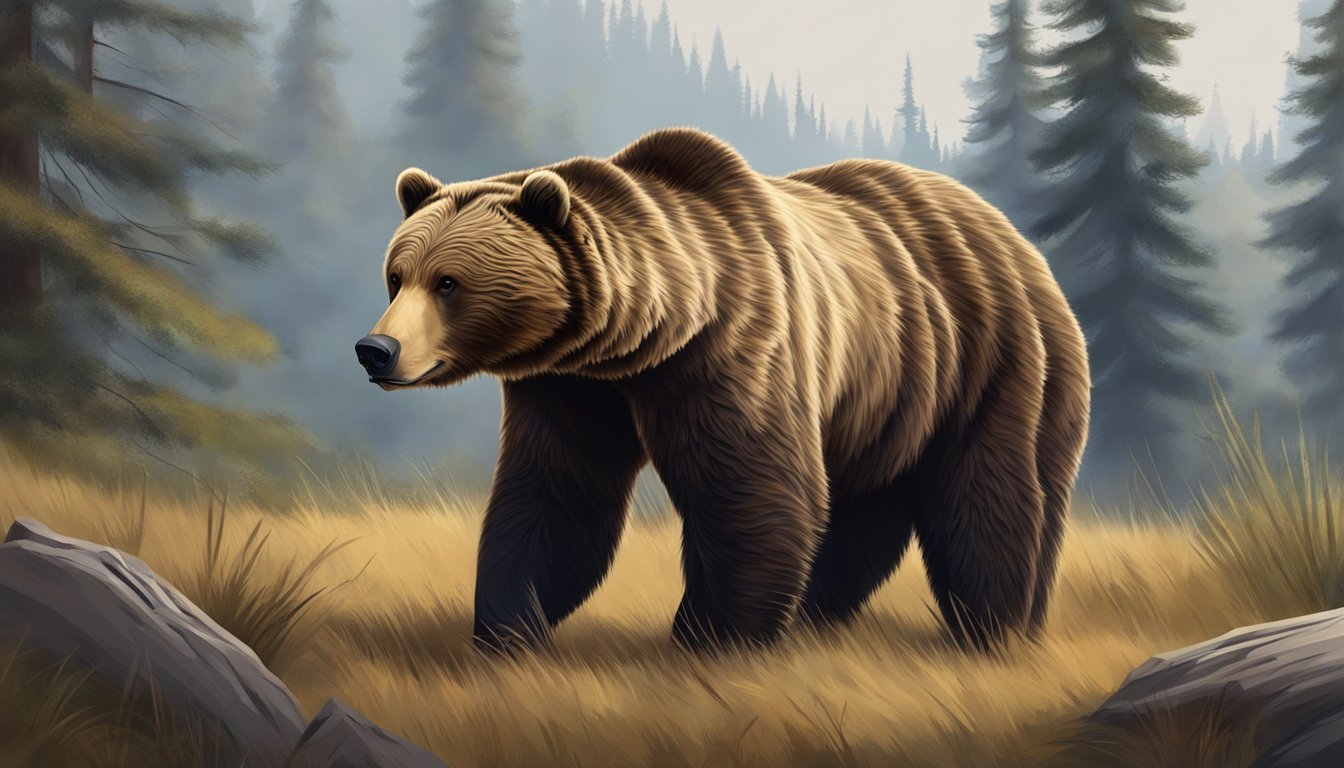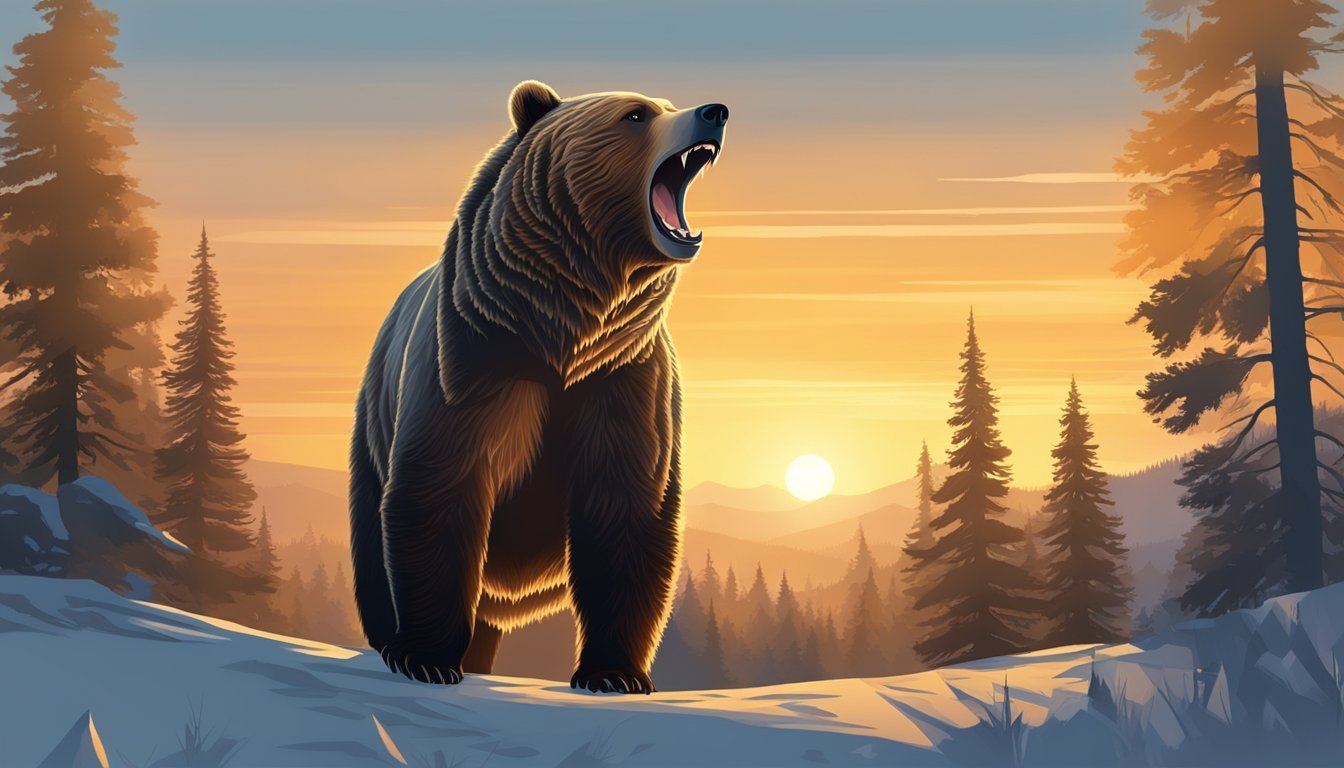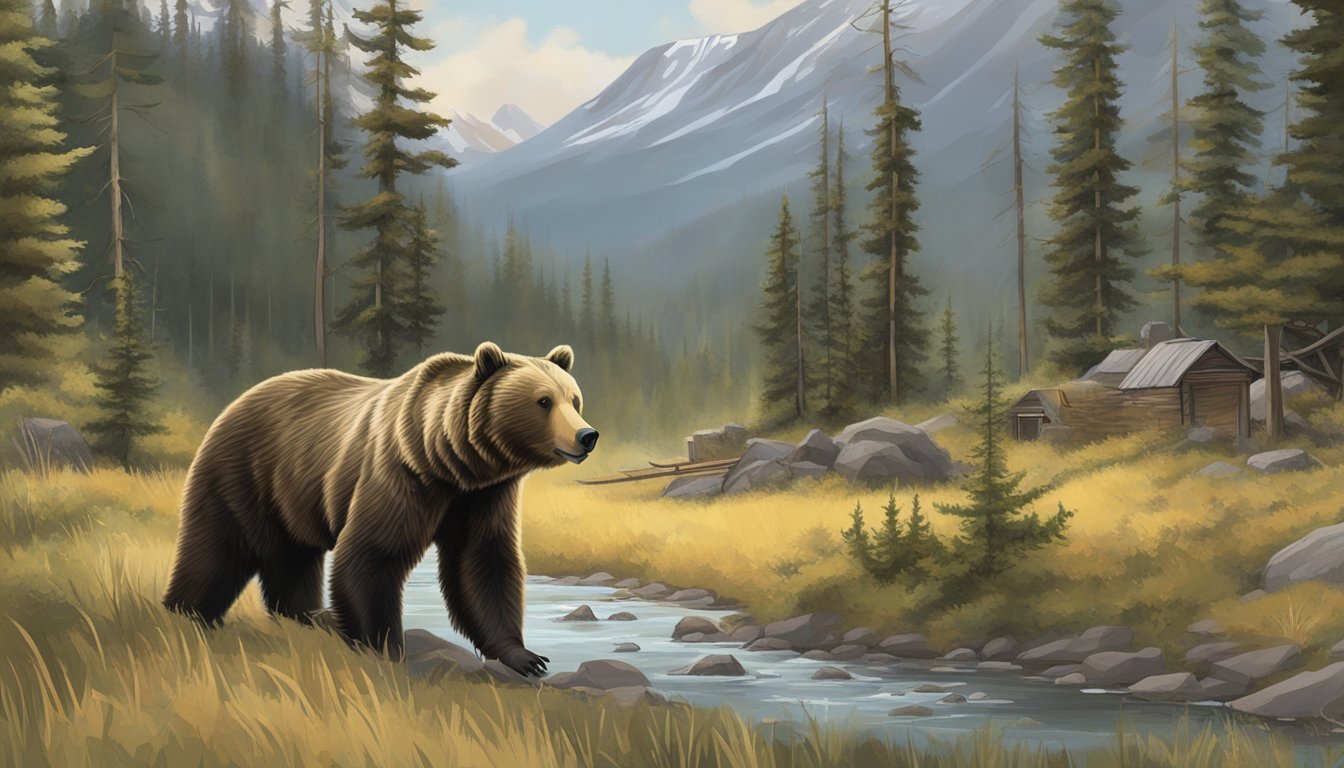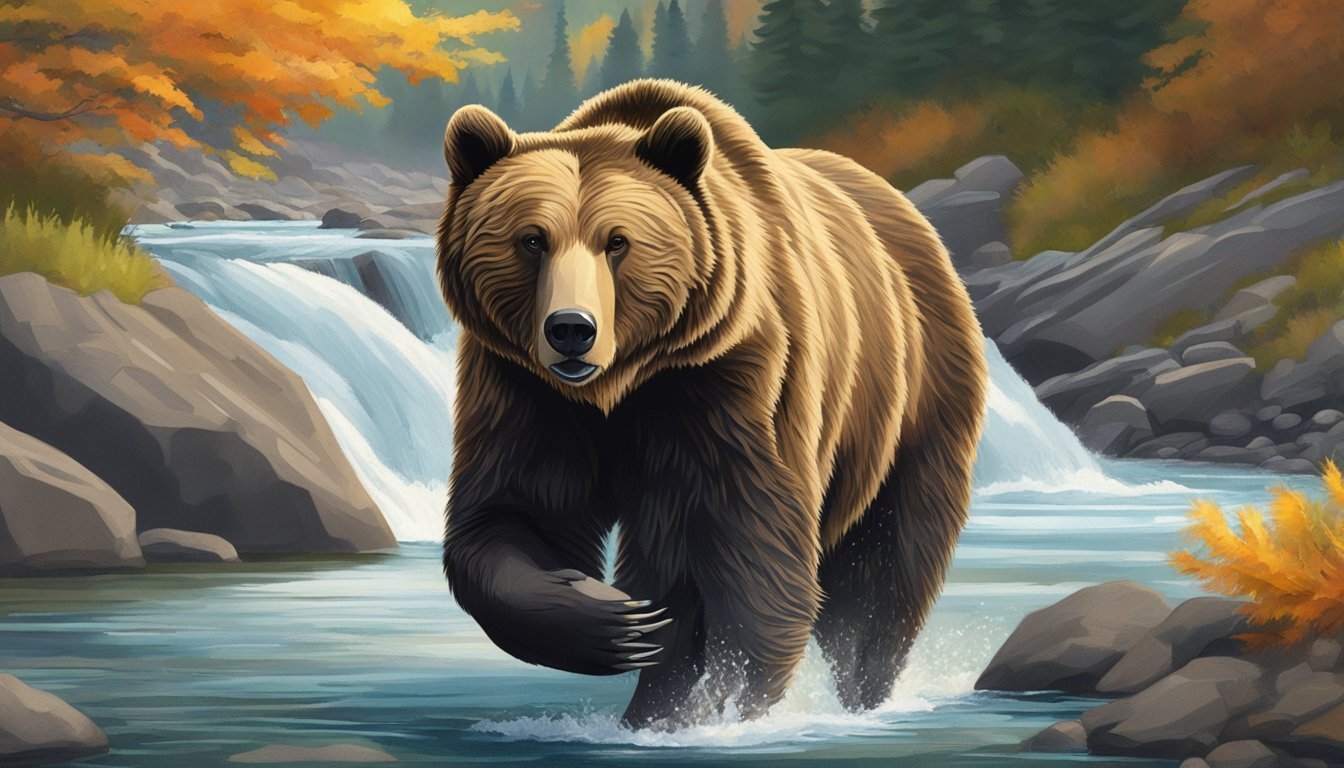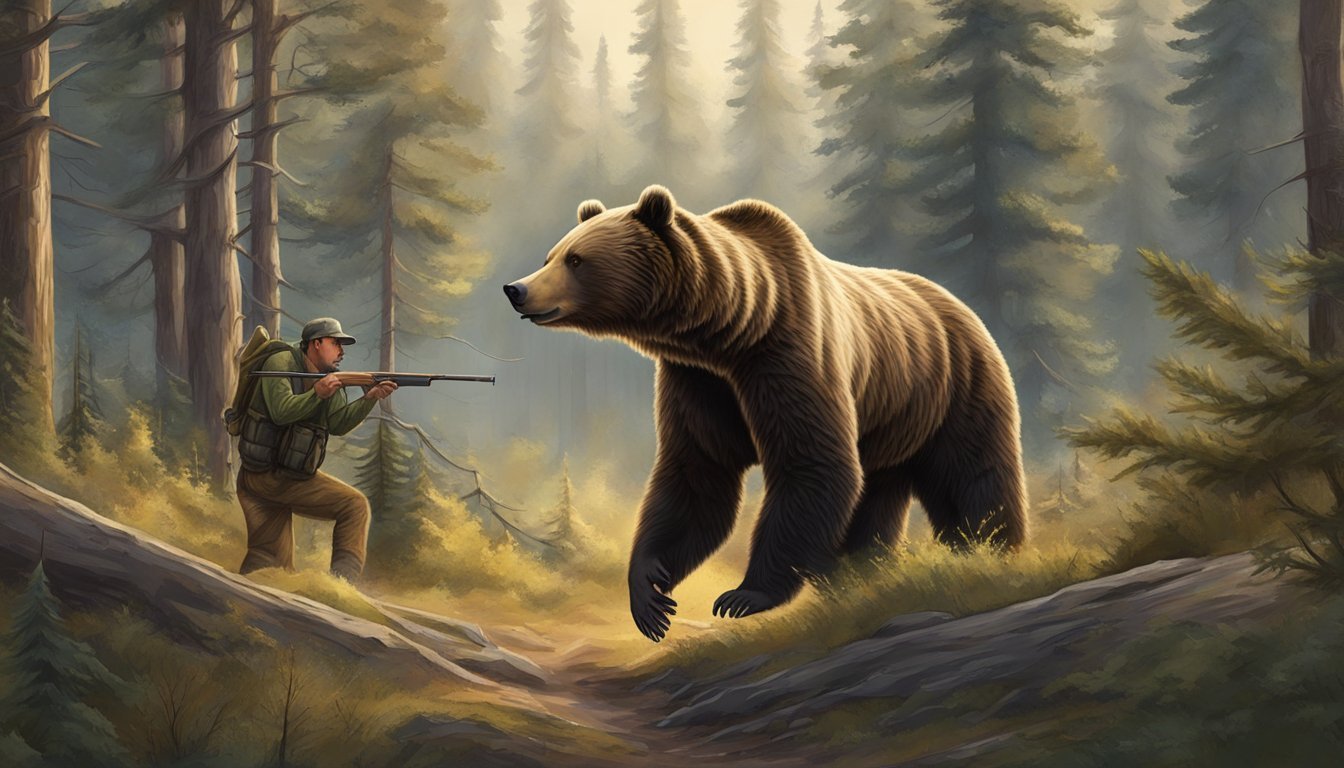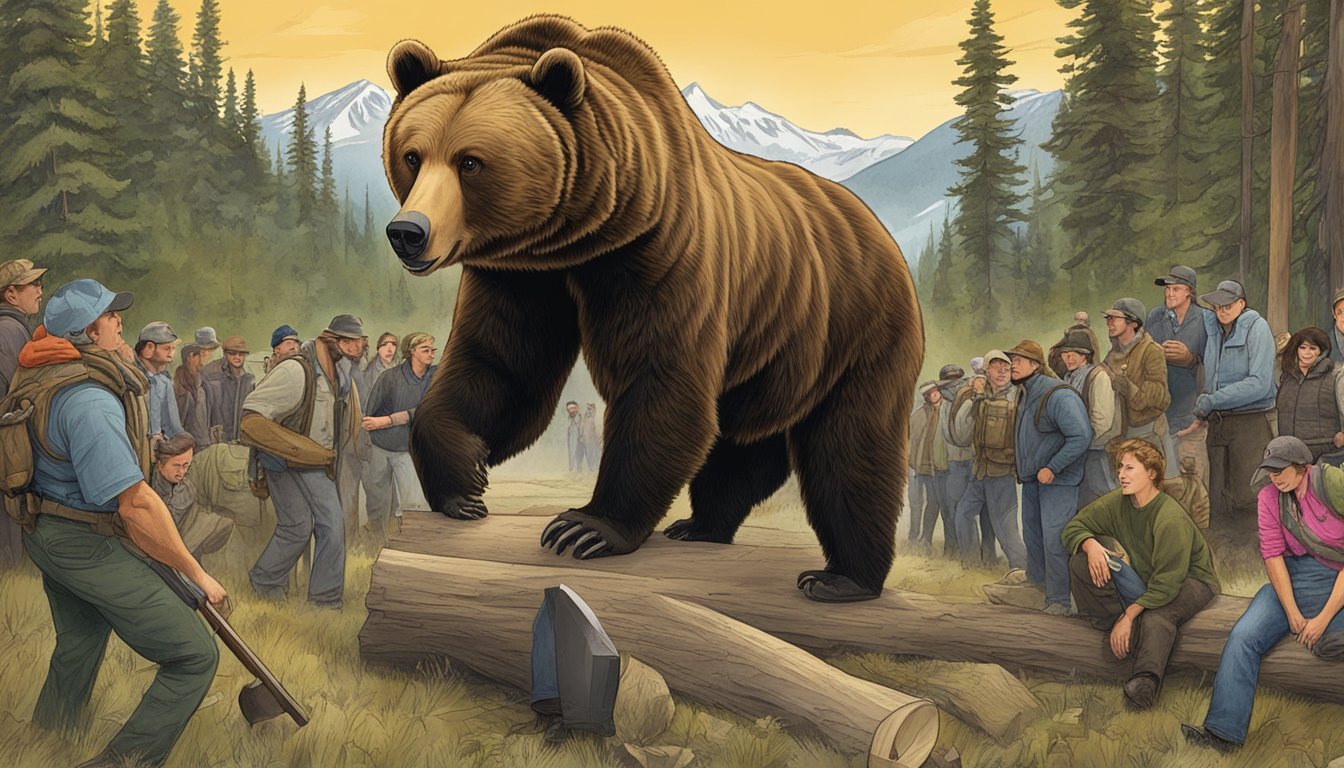Grizzly Bear Hunting Seasons
Regulations and Guidelines
This Article is Part of Our Guide on Hunting Seasons for Over 70 Common Game Species
Grizzly bear hunting has long been a subject of considerable debate among conservationists, hunters, and policy makers. The contention centers on the balance between preserving wildlife populations and managing them for human coexistence and recreational purposes. In the past, overhunting contributed to the significant decline in grizzly bear numbers across the United States, leading to the listing of the species as threatened in most of the lower 48 states under the Endangered Species Act of 1975.
Today, grizzly bears have made a notable recovery due to conservation efforts, particularly in the Greater Yellowstone Ecosystem, where their re-population has been a conservation success story. This recovery has sparked discussions on reintroducing regulated hunting as a tool for managing bear populations. While some argue that carefully managed hunting seasons could ensure the species remains at healthy population levels, others are concerned that opening up a hunting season could threaten the grizzly's survival, especially given the complexities of their reproductive biology and habitat requirements.
Hunting seasons for grizzly bears, where legal, involve meticulous calculations and regulations to support their numbers while considering ecological balance and safety for human communities nearby. Biologists and wildlife managers work together to determine if and how many bears can be culled without impacting the overall population's stability. The debate is dynamic, reflecting societal values, scientific data, and the ethical considerations of wildlife management in an ever-changing landscape.
Grizzly Bear Basics
In this section, we examine the fundamental aspects of grizzly bears, focusing specifically on their species profile.
Species Profile
Grizzly bears, the North American subspecies of the brown bear, are formidable mammals known for their size and strength. They are identifiable by their distinct shoulder hump, dished face, and long claws.
Scientific Name: Ursus arctos horribilis
Physical Characteristics:
Size: Males can weigh between 400-790 lbs (180-360 kg), while females are smaller, typically weighing 290-400 lbs (130-180 kg).
Height: When standing, they can reach heights of up to 8 feet (2.4 meters).
Color: Their fur ranges from dark brown to blond, often with grizzled, or silver-tipped, hairs.
Habitat: Grizzly bears primarily inhabit:
Forests
Subalpine meadows
Alpine tundra
They can be found across North America, with the majority of the population in Alaska and Canada. Small, isolated populations are also present in the contiguous United States in areas such as Yellowstone.
Diet: Their omnivorous diet includes:
Plant material: Berries, roots, fungi, and grasses
Animal protein: Fish (notably salmon), small mammals, carrion, and occasionally larger prey like elk or moose
Population: Grizzly bears were once numerous, spanning across much of western North America. However, due to habitat loss and previous extensive hunting, their numbers diminished. Protecting the species from extinction became imperative, leading to grizzly bears being listed as a threatened species under the Endangered Species Act in the lower 48 states in 1975. Efforts in conservation have allowed their population to slowly increase, with an estimate of over 55,000 grizzly bears now dwelling in North America.
Conservation and Legislation
This section addresses the critical aspects of grizzly bear conservation and the legal framework that governs their management, highlighting the interplay between protection status, regulatory oversight, and hunting regulations.
Protection Status
Grizzly bears once roamed much of western North America but now are listed as a threatened species under the Endangered Species Act (ESA) due to significant population declines. Currently, the U.S. Fish and Wildlife Service (USFWS) is considering delisting grizzly bears in the northern Rocky Mountains, reflecting recovery in their numbers. However, this potential change has sparked a public comment period essential for evaluating the implications of lifting federal protections.
Current Status: Threatened under the ESA
Consideration for Change: Delisting proposal under review
Regulatory Bodies
The primary authority overseeing grizzly bear conservation is the U.S. Fish and Wildlife Service. The USFWS operates under the Department of the Interior and is responsible for implementing the ESA, which includes making listing and delisting decisions based on scientific data.
Main Authority: U.S. Fish and Wildlife Service
Governing Law: Endangered Species Act
Role: Implements ESA, oversees listing/delisting
Hunting Regulations
If delisting occurs, states would assume the management of grizzly bear populations, and this could potentially include establishing hunting seasons. Any hunting regulations would be designed within a framework that ensures the long-term sustainability of the species while considering public safety and the rights of states to manage their wildlife.
State Management: Upon delisting
Potential Outcome: Establishment of hunting seasons
Guiding Principle: Sustainability and safety
Management plans would likely include strict guidelines such as:
Quotas: Limiting the number of bears that can be legally hunted
Zones: Designating specific areas where hunting can occur
Seasons: Defining specific timeframes for legal hunting
The transition from federal to state management is a nuanced process designed to balance conservation successes with the responsibilities and autonomy of states.
Hunting Preparation
Before embarking on a grizzly bear hunt, hunters need to ensure they have the appropriate licenses and a well-prepared equipment checklist. Attention to detail in these areas is essential for a safe and legal hunting experience.
Hunting Licenses
Hunting grizzly bears requires specific tags and licenses that vary by region and state. Hunters should first secure a non-resident license if they are hunting outside their home state. The process often includes a tag fee and can require entering a draw system, especially for limited quotas.
Non-Resident License: Check the state's fish and wildlife agency for application deadlines and fees.
Tags: Tags may be limited and are usually distributed through a lottery system. Apply early and be aware of the draw results dates.
Employing a licensed outfitter can be advantageous, particularly for those unfamiliar with the region or the species. Outfitters are knowledgeable about licensing requirements and can often assist in securing tags.
Equipment Checklist
For a successful and responsible hunt, an extensive gear list is vital. The choice between a rifle or bow should be made based on the hunter's proficiency and legal regulations within the hunting area.
Rifle:
Choose a rifle caliber sufficient for grizzly bear hunting, such as .300 or .338.
Bring enough ammunition for the hunt and any potential practice sessions in the field.
Archery Equipment:
Select an archery setup capable of delivering a powerful and precise shot.
Include various broadheads and ensure you have enough arrows.
General Equipment List:
Firearm or Bow
Ammunition or Arrows
Optics (binoculars, rangefinder)
Hunting knife
Bear spray
Clothing suitable for all weather conditions
First-aid kit
Hunters must check their equipment against an exhaustive gear list before departure, considering both the demands of grizzly bear hunting and the specific terrain they will encounter.
Location and Timing
Grizzly bear hunting seasons vary significantly by location, mainly constrained by geographical regions and seasonal patterns, with regulations designed to manage populations and ensure safety.
Geographical Regions
Alaska is renowned for its population of grizzly bears, which includes the Kodiak brown bear subspecies found in the Kodiak/Afognak Archipelago. The state designates specific regions where licensed hunting is permitted.
In Canada, grizzly bear hunting is legal in certain provinces such as the Yukon and British Columbia. However, in the Northwestern Territories, hunting is restricted to residents.
Within the United States, grizzly bear hunts are regulated and only occur in a few states. The Greater Yellowstone Ecosystem, encompassing areas of Montana, Wyoming, and Idaho, supports a population of grizzlies but is subject to varying degrees of protection and hunting restrictions.
Seasonal Patterns
Hunting seasons are delineated to reflect the bears' behavioral patterns and conservation status. In both the United States and Canada, these seasons can vary:
Spring: Some regions offer a spring hunting season. Dates are set to avoid the period when females are with their cubs.
Fall: This is a common season for grizzly hunting, as bears are more active before winter hibernation.
Location Spring Season Fall Season Alaska Varies by region Varies by region Yukon March to May August to October British Columbia Closed Closed Montana No Open Season No Open Season Wyoming No Open Season No Open Season Idaho No Open Season No Open Season
Each locality establishes its regulations to coincide with the bears' distribution, movement patterns across the range, and ecological needs.
Hunting Techniques and Ethics
Grizzly bear hunting employs a range of methods demanding ethical consideration to ensure sustainability and respect for the animal.
Methods
Grizzly bear hunters typically engage in spot and stalk tactics, where they track the bears, often following signs and prints, to get within range for a shot. Baiting is controversial and often prohibited to maintain natural bear behavior and ecosystem balance. Hunters must be proficient in identifying and tracking game animals, understanding that the goal is a sustainable harvest that respects the natural order.
Tracking: Involves examining physical signs such as tracks, scats, and rubbings.
Spot and Stalk: Hunters locate bears from a distance and quietly approach on foot.
Baiting: Not recommended and illegal in many regions due to ethical and environmental impacts.
Trophy and Meat Handling
After a bear is harvested, ethical handling of the trophy and meat is crucial. Hunters must prioritize proper and expedient meat preservation to prevent spoilage and ensure the animal's resources are fully utilized.
Trophy: Measures such as skull and hide preparation should reflect respect for the animal.
Meat: Expedited retrieval and cooling are essential to honor the life taken and for safety.
Aspect Consideration Meat Cooling It is critical to hang the carcass in a cool, shaded area. Transportation Utilize pack frames or other means to move the meat swiftly. Preservation Game bags can protect the meat from dirt and insects.
Safety and Survival
When venturing into areas where grizzly bears are present, understanding the risks and knowing how to respond to encounters is crucial. Preparedness can greatly increase one's chances of survival and safety.
Encounters and Risks
Grizzly bears generally avoid humans, but certain situations can increase the likelihood of an encounter. For example, hunters processing game may inadvertently attract bears with the scent of fresh kills. To mitigate risk:
Remain Aware: Hunters should be alert at all times, watching for signs of bear activity like tracks or scat.
Make Noise: Making noise can help alert bears to human presence, giving them time to avoid an encounter.
Secure Food and Game: Properly store food and game to avoid attracting bears to campsites or hunting areas.
Carry Bear Spray: A canister of bear spray should be within easy reach, as it is an effective deterrent in the event of an aggressive encounter.
First Aid and Emergency Procedures
In the rare event of a bear attack, swift and appropriate action is imperative:
Use Bear Spray: If a grizzly approaches, use bear spray when it's within close range, aiming low and leading the bear.
Play Dead: In a non-predatory attack, lie flat on your stomach, spreading your legs slightly and using your hands to protect your neck.
Fight Back: If the bear is stalking you (a predatory attack) or if it attacks during the night, fight back focusing on the face and muzzle.
Seek Medical Attention: If bitten or injured by a bear, seek professional medical attention immediately after the encounter.
Carrying a comprehensive first aid kit and knowing how to use it can be life-saving while waiting for emergency assistance.
Economic and Cultural Aspects
Grizzly bear hunting has distinct economic and cultural facets, with guides and outfitters being central figures in the industry, while its economic impact on local communities is notable.
Guides and Outfitters
Guides and outfitters play a pivotal role in grizzly bear hunting seasons. They provide expertise, local knowledge, and often the necessary equipment for hunters to safely and effectively pursue grizzly bears. Outfitters often offer packages that include guides, lodging, and sometimes meals. The cost of these services varies widely, with factors such as location, duration, and the level of luxury impacting the price. The existence of a trophy fee, an additional charge for the successful harvest of a bear, underscores the importance of these animals to the guiding business. The services provided by guides and outfitters are critical for hunters, especially those unfamiliar with the region or the specifics of bear hunting.
Economic Impact
Grizzly bear hunting has a significant economic impact on local economies. Communities near hunting areas may benefit from the influx of visitors requiring accommodation, food, and transportation. Here's a simple breakdown of where hunters' expenditures may go:
Accommodations: Hotels, cabins, camping sites
Dining: Local restaurants, grocery stores
Transportation: Vehicle rentals, fuel costs
Hunting licenses and fees: Conservation and management funding
The ripple effect of these expenditures can be crucial for small, often rural, economies dependent on hunting seasons for revenue. Additionally, the fees generated from licenses and permits directly contribute to conservation efforts, providing a source of funding for wildlife management and habitat preservation.
Grizzly Bear Coexistence
Grizzly bears are an iconic species in North America, playing a vital role in maintaining the ecological balance of their habitats. In areas designated as demographic monitoring zones, strict guidelines and continuous monitoring of grizzly populations provide insight into their recovery and conservation status.
Grizzly bears typically inhabit regions rich in resources such as rivers, forests, and open spaces. These areas often overlap with human activities, necessitating strategies for peaceful coexistence. Maintenance of natural food sources like plants and fish is crucial. Salmon, a vital part of the grizzly diet, especially during the fattening period before hibernation, draws grizzlies to river environments.
Coexistence Strategies:
Education: Informing local communities about grizzly behavior and how to reduce conflicts.
Bear-Proofing: Using bear-resistant containers to secure garbage and decrease attractants.
Conflict Zones: Establishment of safety protocols in areas with frequent bear-human interactions.
Habitat Conservation: Protecting and connecting grizzly territories to prevent them from entering human-populated areas.
Monitoring through demographic mapping allows researchers and wildlife managers to track bear movements and population health. This data aids in making informed decisions regarding the potential for sustainable hunting and conservation measures.
Grizzly bear coexistence is a delicate balance between conservation efforts and human interests. Ensuring a future for grizzly bears necessitates respectful sharing of the land and recognition of the bear's integral role within their ecosystem.
Scientific Research
The Interagency Grizzly Bear Study Team (IGBST) consists of a group of scientists and biologists focusing on the long-term monitoring of grizzly bear populations within the Greater Yellowstone Ecosystem (GYE). Their research plays a pivotal role in understanding grizzly bear ecology, thereby informing management decisions, including hunting practices.
Research by the IGBST has been instrumental in determining population trends, survival rates, and reproduction rates of grizzly bears. Through scientific studies, they assess various factors that could impact these metrics, including human activities.
Population Studies:
Periodic counts and monitoring to estimate population size and growth trends.
Use of non-invasive techniques, such as hair-snare traps, for DNA sampling.
Survival Rates:
Analysis of survivorship across different age cohorts.
Investigation of causes of mortality.
Reproduction Rates:
Monitoring female bears for reproductive success.
Evaluating factors that may influence birth rates.
The data collected by these exhaustive efforts enable wildlife managers to set quotas and seasons for grizzly bear hunting, ensuring that such activities do not imperil the species' survival. However, the actual impact of hunting on grizzly behavior, including the likelihood of reducing human-bear conflicts, remains a debated topic, with ongoing studies expected to shed more light on it.
Adventure and Experience
Grizzly bear hunting in Alaska serves as a stark reflection of the rawness and splendor of nature. The experience is a multifaceted one, offering deep immersion into challenging pursuits and striking landscapes.
Hunting as a Challenge
Grizzly bear hunting is recognized as one of the most challenging big game activities, demanding not only physical resilience but also mental tenacity. Hunters often find themselves navigating the rugged terrains of Alaska, from the dense forests to the alpine meadows. Here, experience is as much about the hunt as it is about survival and strategy.
Seasonal Challenges:
Spring: Thawing ice and snow can make landscapes treacherous.
Fall: Shorter days and variable weather add complexity to hunts.
Hunting these large predators requires a knowledge of bear behavior, tracking skills, and a high level of outdoor survival capabilities. The wilderness dictates the rules, and each hunter must adhere to them to ensure a successful and ethical pursuit of their trophy.
Photography and Viewing
Aside from the pursuit of a trophy, the experience of grizzly bear hunting often includes moments of observation and photography, where the focus shifts to capturing the essence of these majestic creatures against the Alaskan landscapes. Photographers and wildlife viewers find themselves in awe of the intimate moments viewable in the wilds of this great land.
Reasons for Photography and Viewing:
To document the beauty of grizzlies in their natural habitat.
To record the diversity of the wilderness and its landscape.
Both photographers and hunters share a respect for their subject, often seeking to embody this through photos that emphasize the bear's place within the ecosystem. Whether one is behind the lens of a camera or the scope of a rifle, the experience is a testament to the awe-inspiring presence of the grizzly bear and the profound challenge it represents.
Public Perception and Involvement
Public opinion on grizzly bear hunting is nuanced, with a significant portion of the American population expressing approval for legal hunting. Nonetheless, there has been a recent decline in the approval rate, which fell by 4% from the year 2021. Despite this dip, the overall approval remains relatively high at 77%, which is an increase from the low point experienced in 1995.
In particular, residents in rural areas tend to be more supportive of hunting activities. A study by the University of Montana in collaboration with Montana Fish, Wildlife, and Parks, highlighted that while Montanans generally respect the grizzly bear population and its right to exist, attitudes vary when considering the bears' proximity to agriculture or residences.
Key Points of Public Perception:
Support: Strong in rural areas.
Decline: Small decrease in approval of hunting.
Historical Context: Approval has fluctuated over the years.
The debate over grizzly hunting seasons remains contentious. In light of this, wildlife managers have reached out to the public, urging them to partake in efforts like the "#KeepBearsWild" campaign, which embodies a shared responsibility in preventing conflicts between humans and grizzly bears. Public comments and participation are seen as crucial to the successful cohabitation of grizzly bears and humans, particularly in areas where bears are emerging from hibernation.
Wildlife agencies emphasize the importance of community involvement in creating a sustainable environment for both bears and humans. They provide guidelines and ask for public cooperation in reporting sightings and engaging in bear-aware practices. Public input, through comments and survey responses, continues to shape the policies surrounding grizzly bear management.
Appendices
This section provides resources for further exploration of regulations and contact information pertaining to grizzly bear hunting.
Further Reading
Wyoming Grizzly Bear Hunting Regulations: Offers full details on current statutes and legal definitions relevant to grizzly bear hunting in Wyoming.
Alaska Wilderness Enterprises, LLC: Outlines typical costs and expectations for guided grizzly bear hunts in Alaska.
Contact Information for Regulatory Bodies
Wyoming Game and Fish Department:
Address: 5400 Bishop Blvd, Cheyenne, WY 82006
Phone: (307) 777-4600
Website: wgfd.wyo.gov
Alaska Department of Fish and Game:
Address: 1255 W 8th St, Juneau, AK 99811
Phone: (907) 465-4100
Website: adfg.alaska.gov

